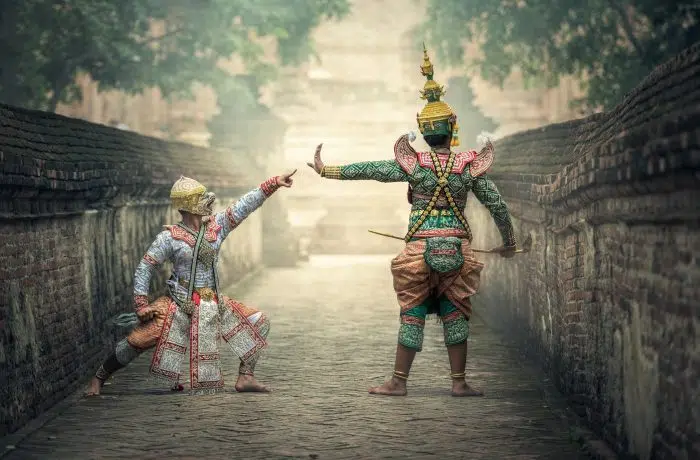Hanuman Guardian, the Monkey King
Hanuman as depicted in the Ramayana and most of the Hindu scriptures is a man with a face of a monkey, having extraordinary strength and supreme powers almost similar to the Gods. He is one of the main characters of the great epic Ramayana, one of the most famous and core mythologies in Asia, especially in and around Southeast Asia.
Ramayama, the story
Hanuman, the mighty ape that aided Lord Rama in his expedition against evil forces, is one of the most popular idols in the Hindu pantheon. Believed to be an avatar of Lord Shiva, Hanuman is worshiped as a symbol of physical strength, perseverance, and devotion. Hanuman’s tale in the epic Ramayana – where he is assigned the responsibility to locate Rama’s wife Sita abducted by Ravana, the demon king of Lanka — is known for its astounding ability to inspire and equip a reader with all the ingredients needed to face ordeals and conquer obstructions in the way of the world.
As is the case for many of India’s gods, several stories are told explaining Hanuman’s origin. In one interpretation Shiva and Parvati decide to transform themselves into monkeys and indulge in amorous games in the forest. As a result Parvati becomes pregnant. Shiva, conscious of his godly responsibilities and desiring to conform to the laws of nature, directs the wind god Vayu to carry the offspring from Parvati’s womb to that of Anjana – an Apsara with the form of a monkey who has prayed to be granted a boy child. In another version of the story Hanuman is simply the offspring of Anjana and Vayu. In yet another version of the story, he is the son of the King and Queen of the Monkeys.
Many stories are also told of Hanuman’s childhood. As the son of Shiva and a monkey, Hanuman is variously described as spirited, restless, energetic and inquisitive. One point all the major texts agree on is his mischievous nature. As a youth Hanuman often abused his powers to pester the saints and holy men living in a nearby forest, with tricks such as beard pulling and the dousing of sacred fires. However, it is as an adult that the monkey god Hanuman comes into his own.
Hanuman’s tale as told in the epic Ramayana is renowned for its ability to inspire its readers to face ordeals and conquer obstructions in their own lives. At the time of the Ramayana, Hanuman is sent as an advance spy to Lanka, the capital of the mighty demon Ravana’s empire. Ravana has provoked Lord Rama by carrying away his beloved wife Sita in order to start a war. During the epic times that follow, Hanuman brings hope and secret messages to the captive Sita, leads Rama’s monkey army in the Battle of Lanka and single-handedly kills many demons including Lankini, champion of the demons. During this time Hanuman is captured by the enemy, only to outwit them with cunning and the use of his powers. He returns to find Lord Rama and his brother Lakshmana themselves captured by the enemy and about to be sacrificed to the goddess Kali by the sorcerer Mahiravana. In a tale of great daring, Hanuman outsmarts the evil lord into becoming the sacrifice himself, thereby earning the eternal respect of Kali. She appoints Hanuman as her doorkeeper and today many of her temples are seen to have a monkey guarding their doorways.
After the defeat of Ravana, Rama and Sita are crowned King and Queen of Ayodhya. Hanuman is offered a reward for his bravery and asks only to continue in service to him and to live for as long as men speak of Rama’s deeds. He remains as Rama’s favourite general to this day.
Because of his bravery, perseverance, strength and devoted service, Hanuman is regarded as a perfect symbol of selflessness and loyalty. Worship of Hanuman helps the individual to counter the bad karma borne out of selfish action, and grants the believer fortitude and strength in his or her own trials during the journey of life.
Hanuman nowadays
The Ramayana, asides other legends and stories inspired in Hanuman, has spread to many Asian countries outside of India including Myanmar, Indonesia, Cambodia, Laos, Philippines, Nepal, Thailand, Malaysia, Sri Lanka, Japan, Mongolia, Vietnam, China and even Afghanistan and Iran. The local version of the story is called Ramakien in Thailand. The story of Ramakien is often represented in Thailand in theaters by actors in masks in dance drama performances knows as Khon. Our logo, inspired in one of such masks, represents the values of this epic character being the core of our company’s foundations built on compromise, trust and loyalty.


